
1st July 2011 was a very special day in Portable Spectral Services (PSS) history. It was the official day the company launched as Portable XRF Services (PXRFS). The ABN was official, the emails, website and doors were on, open and ready for the first hire to be booked out. As some may know, the powerhouse of Portable Spectral Services comes from the Managing Director, Chris Brand and her husband, Nigel Brand.
PSS’ story starts with Nigel, who set up his company Geochemical Services PTY LTD in 2006. Working mainly as a geochemist consultant, Nigel spotted an opportunity in 2009 that involved portable XRF. Being more than just an ideas man, Nigel, excited and motivated, purchased his first XRF – an Olympus Delta. It is here where Nigel had to convince Chris to join in on this venture – creating a hire fleet of portable XRF instruments.
As we are all about science strategies at PSS, it is very fitting that a ‘proof of concept’ project was carried out to test the effectiveness of hiring a portable XRF. This project was created in partnership with Talisman Mining. Needless to say, the proof of concept was a success. As Nigel was already running a business, this venture was Chris’ responsibility and initiative, and thus she became the first staff member of PSS’ original name Portable XRF Services (PXRFS).
The first iteration of the hire fleet was made complete with the purchase of two Olympus Delta’s and two Nitons. Oh, but wait! How could Chris tell them apart? They all looked the same, with very similar serial numbers. Aha! Cue the genesis of PSS XRF naming conventions. The Olympus’ would be named after male Australian actors and Nitons named after female Australian actresses.
Going into the 2011 July launch, Chris had Flynn, Worthington, and Jackman making up the Olympus XRF’s Blanchett and Fisher, the Nitons, in pristine hiring condition.

Dr. Nigel Brand analysing core samples with one of the Portable XRF Services Niton portable XRF’s.
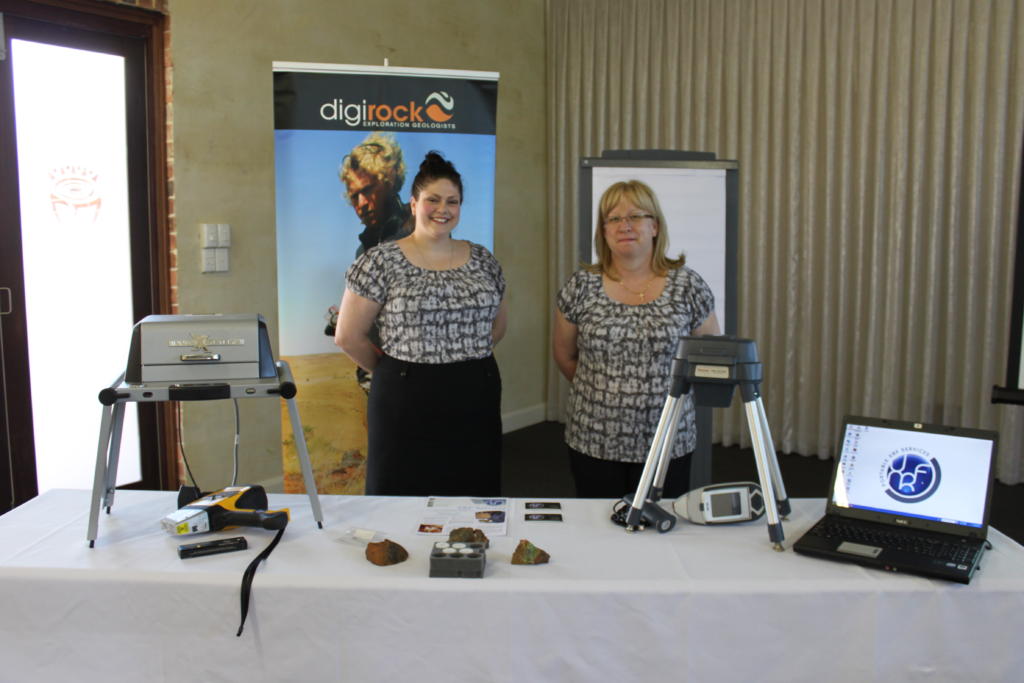
Chris and Rebecca at a training day with Digirock in November 2011.
Going into 2012 PXRFS was continuing to understand its fleet of portable XRFs (pXRF) more intimately. Chris and Nigel wanted to understand where the portable XRF excelled and what were the potential pitfalls and limitations to be aware of. Knowing this information would provide valuable information on how to bridge the limitations of this technology. In addition to this, it would also provide Chris and the team the opportunity to provide more knowledge to clients backed by in-house research and development.
To get into the nitty gritty of portable XRF technology the company undertook a significant evaluation of pXRF instruments. Collaborating with Nigel, the study focused on different models and brands of portable XRF instruments. This included multiple instruments of Thermo-Niton XL3t GOLD+ and Olympus Innov-X Delta Premium models. The study primarily focused on the precision and accuracy of each instrument’s ability to continually provide consistent results on the same certified reference material. What was found in the study was significant. Chris and Nigel therefore thought it pertinent to publish their findings to ensure others utilising this technology could understand strengths and drawbacks in portable XRF technology at the time.
In 2013 this evaluation was presented to the peer reviewed journal Geochemistry: Exploration, Environment, Analysis and “Performance comparison of portable XRF instruments,” was published on the 4th February 2014. In August 2013, Nigel and Chris were fortunate to present their findings internationally at the Denver X-Ray Conference in the USA in a talk titled “Performance Comparison of Portable XRF Instruments: A Mineral Exploration Industry Prospective.” At the end of the presentation there was stunned silence. The academics were asking how we could be so brutal with the technology and yet come up with such amazing results.


Following his talk at the Denver X-Ray Conference in 2014, Nigel is surrounded with attendees who were eager to ask further questions.
The recommendations suggested by Chris and Nigel in the study were adopted as regular procedures within the company that continue to this day. In practicing what they preach, the variation between instruments found in the study is regularly monitored and accounted for to ensure a continued understanding of how each instrument measures over time and across models. The calibration procedure suggested has become standard and is of continued consideration when beginning new projects. When returning to Portable Spectral Services to hire a portable XRF, there is a priority to provide the same instrument as previous hires. This policy was created as a biproduct of this study and follow up in-house studies.
From the early era of Portable Spectral Services there was a focus on research and development and linking this into services and our evolving knowledge base. Research and Development has shaped our company, and how we confidently provide spectral technology to our clients. In addition to this, there can be no doubt that our research has influenced the wider scientific community. As of this year, the article has been cited 52 times in the short seven years it has been published according to Google Scholar. It also encouraged portable XRF manufacturers to innovate further to address issues outlined within the article, with newer models showing greater improvement.

As a way to help bridge the limitations of portable XRF, Portable XRF Services purchased their first SWIR/NIR, a Terraspec 4 ASD in 2014. Having a SWIR/NIR instrument as part of the fleet meant that clients looking more into mineralogy could use both pXRF and SWIR/NIR to gain a more holistic overview of their samples, and therefore answer more questions within potentially one hire period.

As an outcome of various internal studies and proof of concept projects, Portable XRF Services launched a sister company in 2015 that focused on the domestic market. It is estimated there are more than 3.7 million homes in Australia, built prior to 1970 that were previously decorated with lead paint. Healthy Homes and Gardens (HHAG) was established as a provider of a range of services aimed at providing semi-quantitative data that allows customers to take control of their exposure to hazardous materials. Using leading portable XRF technology, the aim of HHAG was and continues to be to educate and assist the community in minimising the risk of exposure to potential hazardous contaminants, such as lead in paint. Originally established for analysing lead in paint and heavy metals in soils, HHAG in more recent years expanded the services to include testing for restricted materials (RoHS), ceramics, and chicken keeps.
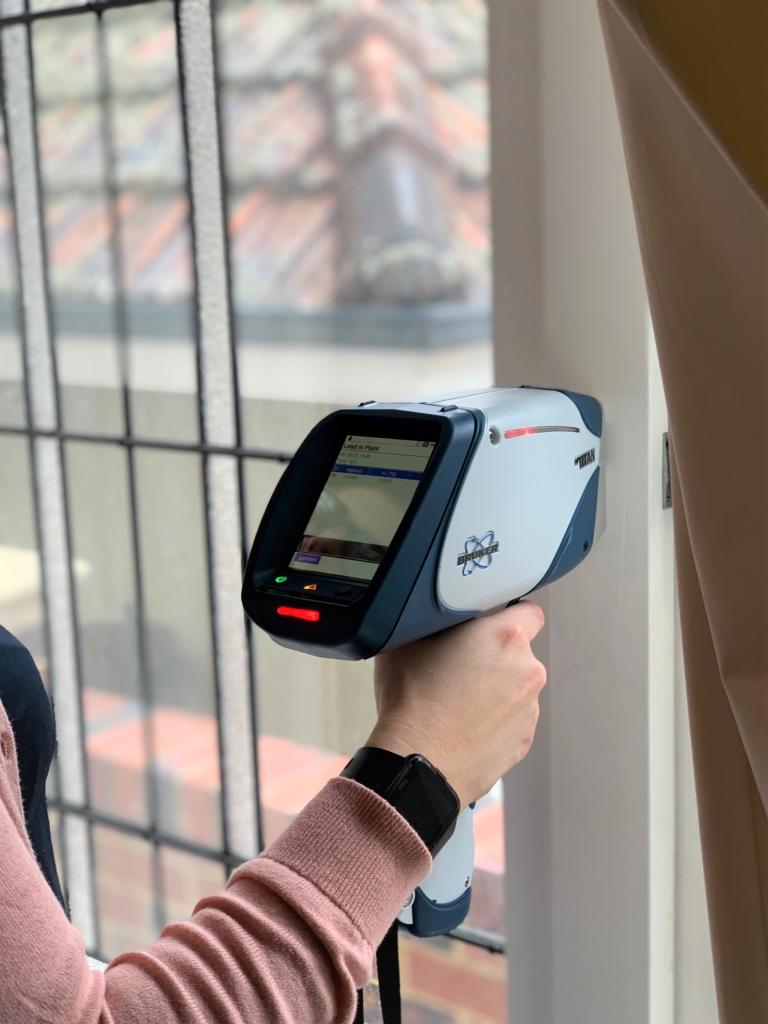
In February 2015 Portable Spectral Services partnered with the powerhouse international company Bruker to become the first authorised application solution centre in Australia. This meant that we were able to begin offering advanced matrix matched custom calibrations on the Bruker instruments.
This was invaluable for PSS, especially to offer such customisation within the world of geology. Distinguishing matrices within samples of interest can often pose difficult, costly, and time-consuming methods. Being able to provide a matrix matched custom calibration on Bruker portable XRF’s (both for hire and client owned) allows companies to minimise time on the identification of matrices within samples, therefore reducing cost. This is because these calibrations are customised to the company’s unique needs and are directly related to their application. The custom calibration focuses in on increasing the accuracy of elemental results on the portable XRF, especially those that are difficult to detect such as lithium. Being able to identify specific elements in samples, means that companies can progress through their project with heightened confidence in their results.
Within this partnership with Bruker, PSS were also able to offer specialised local service solutions -further than basic diagnosis – for all portable XRF Bruker instruments. This meant that PSS could replace or repair faulty instrument parts, update software, calibrate batteries and offer recalibration of the instrument’s calibrations.
As our relationship grew over 2015 with Bruker. This partnership soon expanded, and PSS became an official sales partner for the sale and distribution of Bruker portable XRF instruments. To clearly differentiate sales within PSS as a separate offering from the day-to-day goings of PSS, whilst still providing the same great customer support and service, Portable Analysers Australia (PAA) was established in August 2016. PAA initially offered the sale of the Bruker portable XRF model, S1 TITAN, however this shortly expanded to a wider and more varied range of spectral instruments such as TRACER 5g and CounterTop XRF (CTX).



A bonus of being partnered with Bruker meant that our staff were able to access Bruker’s extensive team of staff. This meant that Chris and Nigel were able to be specially trained on all aspects of Bruker’s spectral instrumentation by Bruker experts. For Chris this meant learning how to create custom calibrations. A very specialised skill that allows the opportunity to manipulate settings on a portable XRF to create prime conditions for collecting data on a target element. This also includes elements that are not able to be analysed on the portable XRF due to limitations of the technology, by instead focusing on trace and associated elements.

In 2016 Chris’ ongoing training and growing skill base in calibration technology brought about the standout calibration “Li Index”. This calibration was the first of its kind as it specifically targeted lithium. To further develop this calibration and opportunities within the mining sector, PSS partnered up with Pioneer Resources. In October 2016 Pioneer Resources intersected caesium during their exploration period. To be able to optimise this rare opportunity, Pioneer engaged PSS to develop for them a caesium calibration on the portable XRF.

An image of Pioneer Resources staff in field using the Bruker S1 TITAN with the Portable XRF Services custom caesium calibration which assisted Pioneer Resources in the intersection of caesium during their 2016 exploration period.
In 2017 the journey of the custom calibration for caesium paid off in spades. In January 2017 Pioneer Resources formally announced the discovery of Sinclair Caesium Deposit. This was a truly incredible discovery as there were only three caesium mines globally prior to this discovery. If you would like to read more, you can find Dr Nigel Brand’s recent article about the Sinclair Caesium Deposit published at the bottom.
In the early months of 2017, Dr Nigel Brand started looking new possibilities and began an interest in Raman spectroscopy. With Nigel’s endless enthusiasm for innovation and opportunity, it was not long before PSS acquired its first portable Raman system – the Bruker BRAVO Raman – in May 2017.
PSS staff began running in-house experiments and case studies to develop an understanding of Raman technology. What was found was that the Raman was easy to use, quick to conduct analysis and non-destructive. The BRAVO Raman excelled in reducing the noise of spectra caused by fluorescence and was able to collect mass amounts of data from a range of specimens including geological or otherwise. Case studies demonstrated that the application is best suited for the identification and verification of samples. Bruker has developed many on-board libraries, which act as the reference to the spectrum being analysed. Meaning, the BRAVO takes a known (the spectrum in the onboard library) and matching it to an unknown (the sample being analysed). The applicability to various industries is far reaching, including pharmaceuticals, and forensics.
For PSS however, the challenge presented by the Bruker BRAVO Raman was for the unknown unknowns – the libraries not yet developed. As PSS is in the heart of WA’s mining industry, this problem was specifically related to geological information not yet developed into onboard reference libraries in addition to how to apply it to a mining scale application like the pXRF or SWIR, e.g., workflow development. So, the Bruker BRAVO Raman completed its initial case studies and was tucked away, with the hope that the right opportunity would arise to further develop it for PSS’ application to the mining industry.
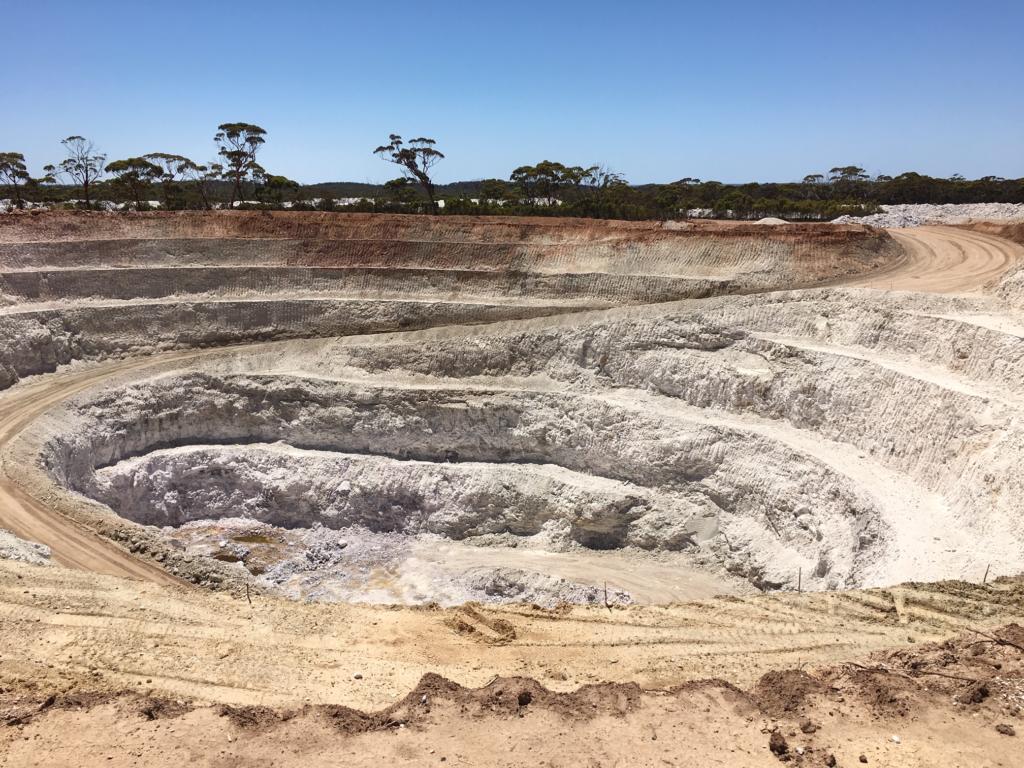
Sinclair Caesium Deposit

Portable XRF Services former staff member Nic analysing a piece of core with the Bruker BRAVO Raman.
A year after obtaining the Bruker BRAVO Raman, Nigel’s enthusiasm struck again with the acquisition of a portable FTIR system – the Bruker ALPHA II – in May 2018. This acquisition, however, was for a larger purpose. Alongside the Raman, which was dragged out of hiding, the Bruker FTIR banded together with SWIR and portable XRF technologies to undertake a deposit scale evaluation at Sinclair Mine. This was a huge undertaking that began in August 2018. Sophie Perring alongside Nigel spearheaded this project. PSS staff spending two-week stints analysing 8 000 drill hole samples and 2 000 grade control samples from the Sinclair Deposit at the Pioneer Kalgoorlie base for roughly three months total.
As part of this project – the ‘spin off series’ – the Bruker BRAVO Raman had a mineral library developed for the identification of LCT pegmatite minerals. This library was initially based on the analysis conducted in Kalgoorlie, which was then expanded upon by the generous access and use of private and public mineral collections across Perth.
This project speaks directly to PSS’ core values that are grounded in a commitment to continued research and development of the application of spectral technologies. Analysing a full-scale deposit on FTIR, Raman, SWIR and portable XRF had not yet been conducted anywhere in the world. It was a way for PSS to demonstrate how the relationship and co-use of these technologies can lead to detailed data, and greater understanding of samples. Pioneer had many exciting ASX announcements during the time the Sinclair Deposit was operational. The PSS project featured numerous times, especially that of the Bruker BRAVO Raman. This is the lasting testament to the way in which spectral technologies can be incorporated into expected, and industry accepted workflows.



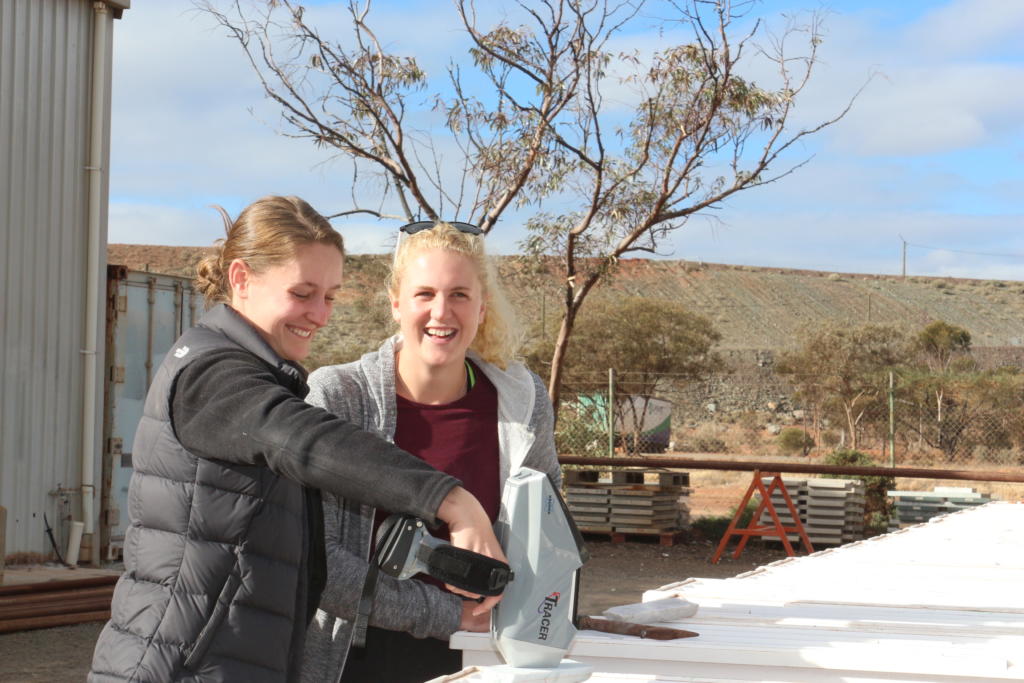

Staff on-site analysing samples from the Sinclair Mine on the portable XRF (TRACER 5g), Raman (Bruker BRAVO), FTIR (ALPHA II), SWIR/NIR

2019 was a busy time of change and possibilities. Hiring out and providing expert knowledge on portable XRFs was the initial objective of the company and was reflected in the founding company name Portable XRF Services (PXRFS). By 2019 however, the company had expanded beyond the scope of just portable XRF technology, now offering hire and services across a range of additional instruments including SWIR/NIR, Raman, FTIR and micro-XRF. In addition to this, the previously separate sales branch of the business which was running under the name Portable Analysers Australia (PAA) had increasing cross overs with the growth seen in PXRFS, the main company. As such, in March of 2019 PAA merged with PXRFS. This meant that all services, sales, and hires were able to be consolidated ‘under the one roof.’
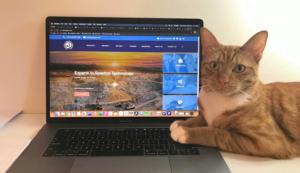
Following this merging, the decision was made to change our founding name Portable XRF Services, as our name no longer mirrored the company’s main objectives. The new name Portable Spectral Services (PSS) was decided upon as it related closely to our established roots of Portable XRF Services, whilst also allowing for the variety of technology to be accounted for. In the press release from July 2019 announcing the change it was noted that “The new name – Portable Spectral Services – comes at a key crossroads for our company.” In conjunction with the rename a new website was launched “to reflect our evolution as a company.”
PSS also launched officially into the Canadian market in September of 2019 where our international staff members operate as an extension of the PSS sales arm. Partnering with Bruker, our tight knit Canadian team work to find solutions and innovations, by selling portable XRF and micro-XRF instruments across a wide range of industries such as academic research, foreign body investigation (FBI) and mining.
In response to buzz around Raman technology and noticing a clear lack of solid, reliable and easy to absorb information on Raman application to the geo mining industry, PSS created a resource website www.georaman.com, where people interested in this technology could learn more. This website features the basic principles and considerations when utilising Raman spectroscopy in the field for mineral identification. PSS continues to update it with current examples of industry exploration applications.
For example, in June of 2019 it was announced the great success of this, where the Bruker BRAVO Raman aided in the discovery of spodumene at Pioneer’s Cade project. This announcement resulted from the deposit scale evaluation at Sinclair Mine carried out by PSS in 2018, where the Bruker BRAVO Raman had a spin off project developing an onboard library for the identification of LCT pegmatite minerals. Once completed, Pioneer was able to utilise the library in the exploration season.
Always seeking out ways to best cater to the needs of our clients PSS developed an online store which launched in September 2020. This store allows clients to book instrument hires, book in for analytical and instrument related services and also stock up on accessories such as certified reference materials all in one place. A significant addition to PSS’ fleet of instruments was the purchase of the Bruker M4 TORNADO micro-XRF. The micro-XRF has transformed the PSS sample analysis services. Whilst purchased in May 2019, PSS did not begin offering the analytical services for micro-XRF until 2020. During the months leading up to offering the micro-XRF as an industry accessible service, our spectral team collaborated in multiple proof of concept studies, test runs and experiments on various settings, samples, and situations. The purpose of this was to develop a thorough understanding of its application and workflows to industry. Potential human error, QAQC methodologies and potential limitations had all been investigated and accounted for in these months. Taking the time to carry out these steps ensured that the team intimately understood and were confident in the technology when working with clients. Being the only micro-XRF analytical service publicly available has meant the M4 TORNADO has proved to be invaluable. So much so that in November 2020 an M4 TORNADO PLUS was ordered to cater for the growing demand. PSS are currently undergoing a similar process to that of the original M4 TORNADO on the new M4 TORNADO PLUS as the additional specifications are accounted for.
Additionally, PSS have developed MineralCube videos, based on micro-XRF data, allowing clients to visually see how minerals are distributed within a sample. As micro-XRF technology was proving to be incredibly exciting, PSS created a resource website www.microxrf.com.au for clients and interested parties to learn more about the technology and how it could be applied to their unique needs.

Current Portable Spectral Services staff member Andrew loading a sample onto the M4 TORNADO.

Dr. Nigel Brand in front of new M4 TORNADO PLUS
2021 marks Portable Spectral Services 10th year in business. Marked with a lot of excitement, it has been the perfect moment to look back and see how far the Company has come. Innovation, research, and development have always been at the core of the Company’s values. This has been largely reflected in the opportunities, partnerships, and discoveries we have been part of over the past
decade. We want to take this opportunity to thank our clients, past and present for their support and continued trust in our staff as the experts in
spectral technology.

Portable Spectral Services Spectral Team with the M4 TORNADO (left) and the M4 TORNADO PLUS (right) in the dedicated micro-XRF area of PSS’ new office at 1/9 Colin Street, West Perth.
Ready to see it all again? PSS made a timeline graphic as part of our 10 year celebrations!!
2014 Study
Brand, N. W., and C. J. Brand. “Performance comparison of portable XRF instruments.” Geochemistry: Exploration, Environment, Analysis 14.2 (2014): 125-138.
Denver X-Ray Conference 2013 information https://www.icdd.com/axa-allvolumes/#vol57
Deposit Scale Evaluation of Pioneer Resources Sinclair Caesium Deposit
Dr Nigel Brand’s recent article in EXPLORE: https://www.appliedgeochemists.org/sites/default/files/documents/Explore%20issues/EXPLORE190-MArch2021.pdf
Or visit EXPLORE Newsletter (Association of Applied Geochemists)
https://www.appliedgeochemists.org/publications/explore-newsletter
Dr Nigel Brand being interviewed about the project by Bruker 2020:
Announcements
Pioneer ASX Announcement that involved PSS LCT Pegmatite onboard library on the Bruker BRAVO Raman.
PSS Micro XRF Analytical Service featured in ASX Announcements: https://www.microxrf.com.au/application-announcements
PSS name change: https://www.portaspecs.com/press-release-name-change-announcement/
Recent PSS article on current experiments being run on M4 TORNADO PLUS https://www.portaspecs.com/light-elements-significant-improvement-in-analytical-response-using-the-m4-tornado-plus/
Resources
Sister Company – Healthy Homes and Gardens https://www.healthyhomesandgardens.com.au/
Monthly Newsletter signup https://www.portaspecs.com/newsletter/www.georaman.com For all things related to Raman spectroscopy.
www.microxrf.com.au To dive deep into micro-XRF technology.
Check out PSS Online Store here: https://www.portaspecs.com/product-category/online-store/
Social Media
Professor Spectrum For videos on Spectroscopy
MineralCube videos are available to be created for clients utilising the micro-XRF analysis as another method to visually interpret samples of interest.
Linkedin https://www.linkedin.com/company/portable-spectral-services
Coming Soon
Portable Spectral Services will be launching their Canadian website at portaspecscanada.ca
Portable Spectral Services’ Schedule of Hire, Support Services & Fees is now available!